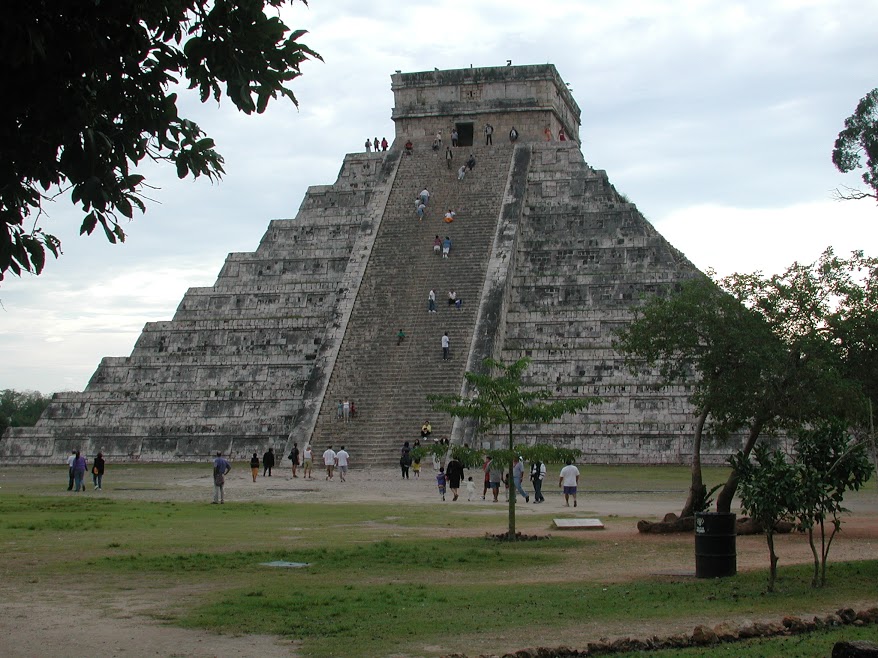Chichen Itzá, Yucatán, México
26 December 2001Somewhere on the old highway between Cancún and Mérida lies Chichen Itzá. The ruins at this site cover over 15 square kilometres, with El Castillo alone taking up 0.4 hectares. At 83 metres in length, the Ball Court is the largest in Meso-America. The close proximity of the ruins to Cancún and the size of some of the structures have made these the most famous Mayan ruins in the country.

The image that most people associate with Chichen Itzá is El Castillo. The pyramid rises more than 23 metres above the ground, with steep staircases up all four sides, leading to a small building at the top. What’s so spectacular about it is the fact that this pyramid is actually a huge Mayan calendar built of stone. The four staircases leading to the top have 91 steps each, which when added to the platform at the top, make 365. On the sides are 52 panels representing the 52 years of the traditional Mayan calendar round. The pyramid is composed of nine terraced platforms on either side of the two primary staircases, for a total of 18, the number of months in the Mayan calendar. If you’re still not convinced of the Mayans’ astronomical prowess, you can easily convince yourself by visiting on either the spring or the fall equinox when, as the sun rises over the jungle, the form of a giant serpent is projected onto the sides of the two primary staircases, each of which has a giant stone serpent head at its base. This illusion is created by the precise alignment of the terraces in relation to position of the sun.
In a corner in the shade of one of the giant staircases leading up the side of El Castillo is a door. Once or twice a day, the door is opened, and groups of 20 or so are allowed inside. A narrow passage leads to a steep staircase that runs up the side of another pyramid inside El Castillo. It’s narrow, cramped, hot and humid, not to mention dark, but the climb is worth it. Eventually, at the top of the staircase, if you’re lucky or pushy enough, you can catch a glimpse of a jewel-encrusted jaguar altar, used by the Maya for sacrifices.

The Ball Court is another feat of engineering. The walls are each approximately 8 metres high, with structures at the top for viewing the game. At either end of the court is an elaborate stone temple. But what is so amazing about the Ball Court is its acoustics. A whisper at one end can be clearly heard at the other end, 135 metres away. In fact, the sound reflection at the centre of the court is so incredible, you can hear at least nine echos if you clap or shout.
The following excerpt, by one of the supervising archaeologists restoring the ruins, describes the acoustics:
Chi cheen Itsa’s famous ‘Ball-court’ or Temple of the Maize cult offers the visitor besides its mystery and impressive architecture, its marvellous acoustics If a person standing under either ring claps his hands or yells, the sound produced will be repeated several times gradually losing its volume, A single revolver shot seems machine-gun fire. The sound waves travel with equal force to East or West, day or night. disregarding the wind’s direction. Anyone speaking in a normal voice from the ‘Forum’ can be clearly heard in the ‘Sacred Tribune’ five hundred feet away or vice-versa. If a short sentence, for example, ‘Do you hear me?’ is pronounced it will be repeated word by word… Parties from one extreme to the other can hold a conversation without raising their voices.
This transmission of sound, as yet unexplained, has been discussed by architects and archaeologists … Most of them used to consider it as fanciful due to the ruined conditions of the structure but, on the contrary, we who have engaged in its reconstruction know well that the sound volume, instead of disappearing, has become stronger and clearer… Undoubtedly we must consider this feat of acoustics as another noteworthy achievement of engineering realized millenniums ago by the Maya technicians.
—Chi Cheen Itza by Manuel Cirerol Sansores, 1947
Aside from the Ball Court and El Castillo, there are dozens of other sites of interest. There are no less than three cenotes around the site, one of which was filled with tens of thousands of artifacts, from neclaces and jewelry to the bones of human and animal sacrifices. The Hall of the Thousand Pillars is also incredible to walk through, with each pillar featuring unique carvings and inscriptions; on some, traces of red and blue paint are still visible.
The site was originally populated by the Itzáes around 500 AD, and slowly built up until 900 AD, at which point it was completely abandonned. No one knows why the Itzáes left so abruptly, but it appears that the city was re-populated about 100 years later, and then attacked by the Toltecs, a tribe known for its brutality at war. Structures from the period between 1000 and 1300 AD show marked Toltec influences, including numeral reliefs of Toltec gods, including Quetzalcoatl, the plumed serpent. The city was abandonned once again around 1300, this time permanently.